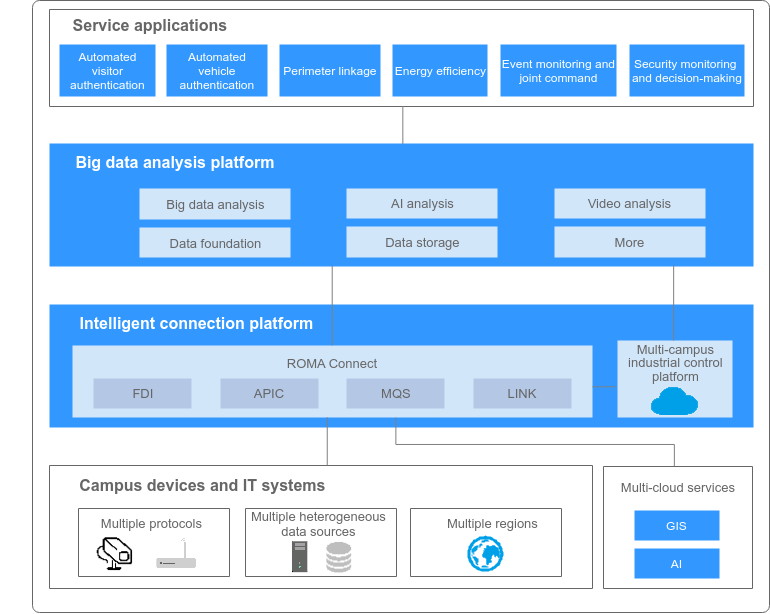Smart Campus Integration
Many difficulties are encountered in smart campus management:
- Customized management systems hinder information collection and sharing.
Buildings in a campus have different structures. Enterprises can customize subsystems for each building to collect all information on each one. However, after customization, the differences between subsystems hinder information collection and sharing, resulting in difficulty in information transmission. This reduces the "smart" level of a campus.
- Diversified devices and complex data collection make it difficult to implement system linkage.
In scenarios such as vehicle entrance and exit management, visitor registration, and campus asset management, it is difficult to implement linkage management due to the complexity of data collection and centralization.
- The status of important devices cannot be remotely monitored in real time, so warnings cannot be generated.
For example, faulty street lamps cannot be alerted and must be manually repaired in a traditional campus, resulting in passive maintenance.
ROMA Connect has a complete set of integration solutions involving devices, data, and services to help enterprises build smart campuses.
- Efficient interconnection with various devices from different vendors
Information about devices from different vendors, such as cameras, turnstiles, and air conditioners, is sent to LINK using the standard MQTT protocol. In addition, LINK is connected to multiple IoT platforms, eliminating the need to collect data from each platform separately.
- Data base construction for providing standard data services
FDI and MQS quickly integrate all data and open the data to different backend services of an enterprise. For example, vehicle data in turnstile systems, device status in asset management systems, and switch-on/switch-off and device information in street lamp systems are transmitted to backend services in real time or in asynchronous mode for analysis and linkage management.
In addition, the high scalability design provided by ROMA Connect supports huge data transmission and storage on the campus network, improving data transmission efficiency.
- Integration of IT, OT, and AI for building an intelligent operation center
ROMA Connect provides a channel for data integration and sharing. Enterprises, then, can use the enterprise-grade AI, video analysis, and big data services to build a smart campus.
- Centralized and distributed architecture for supporting campus services
Enterprises holding large campuses often need to manage multiple campuses. The centralized and distributed architecture of ROMA Connect helps these enterprises integrate data from multiple campuses onto the same platform and assists them in managing the distributed and centralized operations based on actual conditions.
Figure 1 Smart campus integration
Feedback
Was this page helpful?
Provide feedbackThank you very much for your feedback. We will continue working to improve the documentation.See the reply and handling status in My Cloud VOC.
For any further questions, feel free to contact us through the chatbot.
Chatbot





